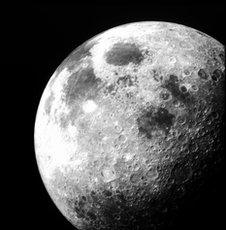'Much more water' found in lunar rocks
- Published

Some of the water on the Moon may have been delivered by comets
The Moon might be much wetter than previously thought, a group of scientists has said.
A US-led team analysed the mineral apatite in lunar rocks picked up by the Apollo space missions and in a lunar meteorite found in North Africa.
The scientists found that there was at least 100 times more water in the Moon's minerals than they had previously believed.
The new study has been published in the journal PNAS.
This group is one of several different teams of researchers hunting for evidence of water on the Moon - and clues to how it got there.
Lead author Francis McCubbin from the Carnegie Institution for Science in Washington DC told 大象传媒 News that the water content on the Moon ranges from 64 parts per billion to five parts per million.
"It would be about 2.5 times the volume of the Great Lakes," he said.
"Or another way of looking at it - if you took all of the water that was locked up inside the rocks of the Moon and put them on the surface, it would make a metre-thick layer covering the Moon."
The scientist explained that the Moon most probably formed after a Mars-sized space body collided with the young Earth, some 4.5 billion years ago.
The high-energy impact produced molten debris, which eventually cooled to form our planet's only natural satellite.
Back then, he said, there was a magma ocean on the Moon. Magma contained water, which eventually erupted via "fire fountains" on to the lunar surface.
Most of this water evaporated during the volcanic activity - but some of it stayed, said Dr McCubbin.
"I like to use the analogy of someone who's trying to make non-alcoholic beer. There's always going to be some alcohol left," he explained.
Quest for water
After the US Apollo space missions of the late 1960s and early 1970s returned to Earth with numerous samples of lunar rocks, scientists spent years examining them in search of water.
At first, they declared that the Moon was dry - but this theory was challenged in 2008, when a US team used the method of secondary ion mass spectrometry (SIMS) and found evidence of water in lunar volcanic glasses - pebble-like rocks that ended up on the Moon's surface after the volcanic outpouring.
It was a breakthrough discovery, even though the quantity of water was only of the order of 46 parts per million.
Nevertheless, the scientists said that their research shed light on the origins of lunar water, asserting that it was "native" to the Moon.
Earlier in 2010, a radar experiment aboard India's Chandrayaan-1 lunar spacecraft found thick deposits of water-ice near the Moon's north pole.
In the recent study, Dr McCubbin and his colleagues used SIMS to look at the Apollo samples once more - but this time, they analysed the only water-bearing mineral of the rocks - apatite.
Apollo missions brought many lunar rocks back to Earth
This mineral happens to be a major component of tooth enamel and bones and, as Dr McCubbin explained, "has a better chance of retaining water than volcanic glass".
The team specifically studied hydroxyl (OH) - a chemical compound in apatite that contains one atom of oxygen and one atom of hydrogen.
The researchers combined their measurements with models that analyse how the material crystallised as the Moon cooled.
The team found that the Moon's interior contains at least 100 times more water than was previously believed, stored in lunar minerals.
Other researchers have called the results important for future studies.
"It is gratifying to see this proof of the OH contents in lunar apatite," commented lunar scientist Bradley Jolliff from Washington University in St. Louis, Missouri.
"The concentrations are very low and, accordingly, they have been until recently nearly impossible to detect. We can now finally begin to consider the implications鈥攁nd the origin - of water in the interior of the Moon."
Other theories
Dr Lawrence Taylor from the University of Tennessee in Knoxville, US has been involved in a separate, but similar research.
He told 大象传媒 News that besides finding water in the apatite, he and Jim Greenwood from Wesleyan University in Connecticut have come up with an additional theory about the origins of lunar water.
"We're thinking now that there might have been a cometary input as well," said Dr Taylor.
He explained that there were a lot of comets flying around at the time of the Moon's formation, "hitting the little, nascent, early Moon some 4.5 billion years ago".
Some scientists call comets "dirty icebergs" as they mostly contain ice, as well as other rocky material, soil and gases.
"So maybe there was a lot of cometary debris going by and as these 'dirty icebergs' hit the Moon, they provided a lot of water input," Dr Taylor said.
"Back then, the outer portion of the Moon was molten, it was all a lunar magma ocean, so the comets were incorporated into the chemistry of the [Earth's satellite]".